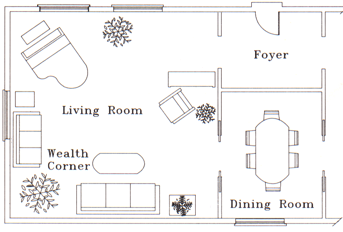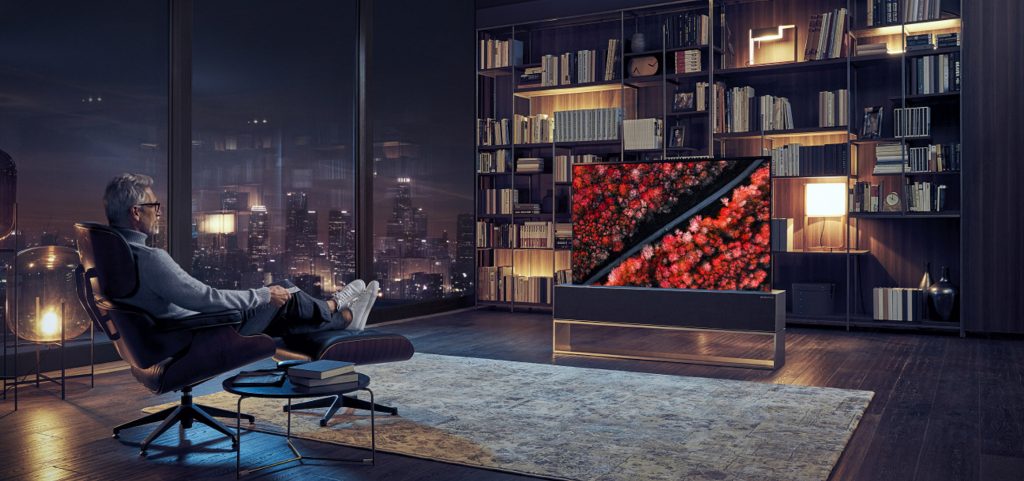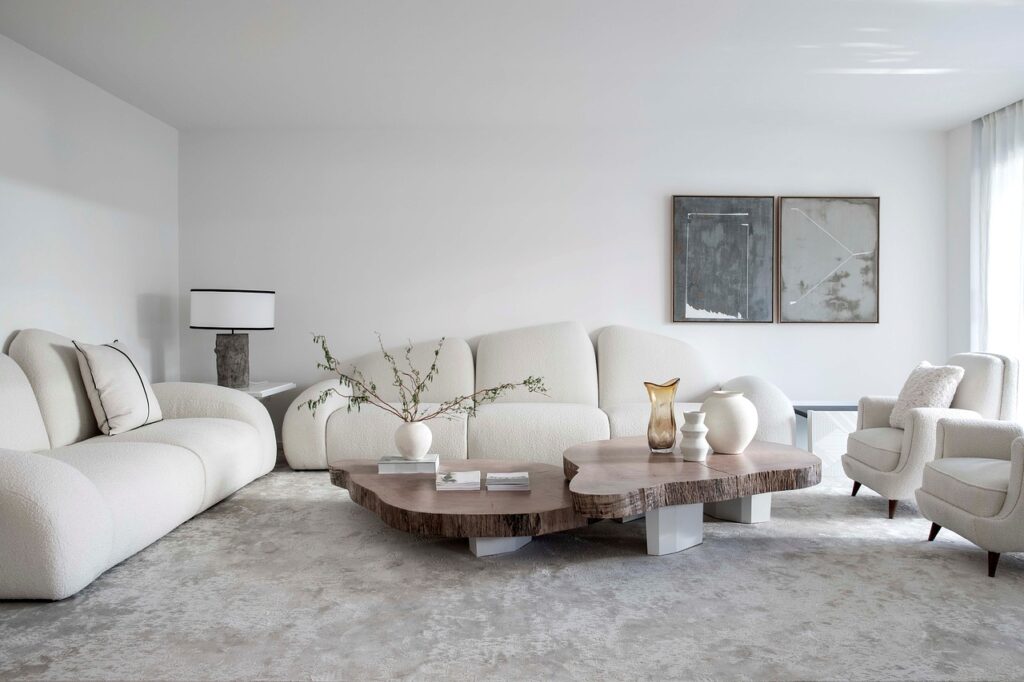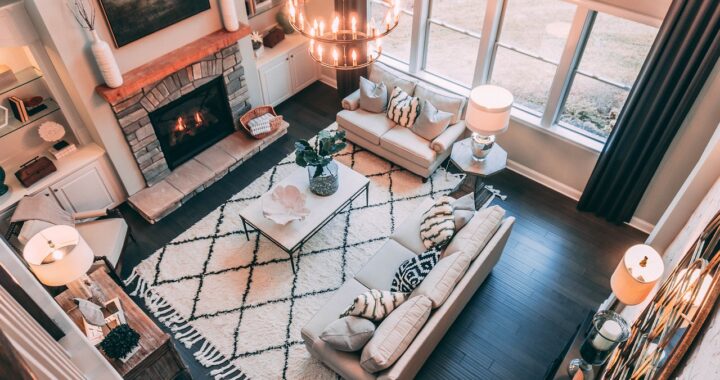Our living spaces can benefit immensely from feng shui, an ancient Chinese practice that harmonizes individuals with their surroundings. Let’s explore how to effectively incorporate feng shui’s principles and five elements – water, wood, fire, earth, and metal – into your living room to foster a more balanced and serene environment.
The orientation of living rooms
The best places compass-wise are south, south-west and west facing. West direction has a relaxing quality of energy.
Layouts
The layout of your living room will depend on the shape of the room. Work with the function first and see how it looks and how the energy will flow.
Strong focal points
A strong focal point or points are essential for establishing the context and ensuring that you can relax and orient yourself in relation to key features. The focal point can be organised around anything when done well and with thought. The TV set is no longer a focal point in many living rooms.
Furniture
The choice of furniture will depend on your style preference. For example, the Moroso modular seating system consists of chairs, sofas and coffee tables in different shapes and sizes that fit together like a jigsaw puzzle.

Feng shui of the living room
Strong tables
Strong tables will have a grounding and stabilising effect.
HiFi
If you have a wifi router somewhere in the living room, make sure it’s far away from any seating areas. Wifi routers are a source of electro-smog and shouldn’t be placed near people. Obviously, you should switch off wifi router for the night to ensure a good, healthy sleep.
TV set
TV sets have come a long way, and for the better. The latest versions are roll-up TVs that can be easily stored, so the TV is not a huge focal point. If you’re a great TV fanatic, then a centrally placed TV is fine. For ages, the TV set was a focal point in any living room – these times are gone, and the television is now going incognito. There is a growing trend for redesigning the living rooms where the box is hidden or concealed or not there at all since more and more people watch media on their tablets or mobile phones. After all, the living room doesn’t have to be organised around the TV set as a focal point. With micro-living trends, homeowners are looking for new ways to maximise their space and hide the sets and use the space for other things. And since the TV sets are no longer focal points, people are moving away from traditional setups where the TV is a focal point. LG Electronics produced the first roll-up 65in Oled TV, made of an ultra-thin material that rolls into a thin box that doubles as a speaker. If you can’t afford this high-end TV, you can paint the wall on which the TV is positioned with dark colours similar to the television, so the set doesn’t dominate the wall so much. Also, placing the TV off-centre, not as a focal point, will help. Another popular and quite inexpensive way is to use mirror frames over flat-screen TV to hide it when it’s not used. You can obscure the view of the TV set with art and screens or hide it in built-in cupboards, etc. Mini projectors are another way, as long as you have a clear wall to project the movies.
(In bedrooms, people use bed frames to hide the TV sets. I personally don’t recommend it unless you unplug the TV after use to minimise the electro-smog at the foot of your bed. The off-grid bedroom with minimal electro-smog and electronic distractions is the best option for healthy sleep.)

LG roll-up TV in the living room
Lighting
Living rooms need a variety of lighting, i.e. ceiling, table, low level, and wall lighting, to give full flexibility for the lighting mood you want to create.
Photos of the family and friends
Surrounding yourself with photos of family and friends creates a wonderful sense of family, friendship and community. The more, the better.
Pastel colours, yellow (gathering)
When it comes to the colour scheme for the living room, again, it’s up to your preference for the style. A major influence might be the compass orientation and the amount of light the living room receives.
Bookshelves/library
In spite, of the Kindle revolution, bookshelves and libraries are having a great time. The more books you have, the better. Research suggests that people who have books on display are happier than those who don’t.
Plants, fresh, cut flowers
Plants, flowers and cut flowers add that extra fresh live energy. Avoid dry or plastic plants or flowers – no matter how great they look, they don’t have any energy (chi/qi).
Oval, round shapes (tables, avoid glass)
Research (and my own) suggests that relaxing shapes are round, oval and with flowing lines. It’s best to avoid glass tables since they can make people a bit self-conscious when placing objects on them.
Fun things for joy and play
Play is an essential requirement for relaxation. Make your living room playful and fun. Have lots of games, puzzles, magic tricks, and fun things to do. Research suggests that play is an antidote for uncertainty. Also, researchers found out that joy is key to a happy and contented life. Read more about the importance of joy and happiness
Balancing the feng shui five elements in your living room
Water: Flowing Serenity
The water element in feng shui represents wealth and prosperity. To incorporate this element into your living room, consider adding a small water feature or aquarium. Wall art featuring seascapes or rivers can also evoke the water element. Blue and black accents, through cushions or rugs, can subtly bring in the water element, fostering a sense of calm and tranquility.
Wood: Vibrant Growth
Wood, the element representing growth and vitality in feng shui, is best introduced via plants. Houseplants, wooden furniture, or green décor items can instil a sense of life and renewal in your living room. Even artwork featuring forests or trees can echo the wood element’s energies. However, ensure your plants are healthy and well cared for, as dying plants can lead to stagnant energy.
Fire: Sparking Passion
Fire, signifying transformation and passion, can be brought into your living room through the use of warm colours such as red, orange, and pink. Candles in safe holders can also represent the fire element (actual candles are not recommended since they create air pollution – use lighting or Himalayan salt lamps). An elegant fireplace can be a focal point for the room, creating a warm and welcoming ambience. Even images of sunsets or bright lights can invoke this fiery element.
Earth: Grounded Stability
Earth, symbolising stability and nourishment, can be introduced through the use of earth-toned colours, such as browns and beiges. Heavier furniture pieces and square or rectangular shapes can further echo this earthy energy. Ceramic vases or pottery, landscape art, and crystals like agate or quartz can also help in bringing the grounding earth element into your living room.

Metal element with a bit of wood/tree. Generally, it’s best to avoid too much of one element unless it’s designed for a specific feng shui effect or as a remedy.
Metal: Clear Precision
Metal, representing clarity and precision, can be incorporated into your living room through the use of metal furniture or décor items. Shades of white, grey, and pastels also symbolize the metal element. Round or oval shapes, mirrors, and metal art can further enhance this element, promoting a sense of sharpness and clarity in the room.
In conclusion, balancing the feng shui five elements in your living room is about more than aesthetics. It’s about creating a space that nurtures your well-being and supports positive energy flow. Whether you’re redesigning your living room or making minor adjustments, these feng shui principles can guide you towards a harmonious, balanced living space.
To sum up
1) Make the living room a relaxing place.
2) Make it fun and enjoyable as well as playful.
3) Define different areas clearly if it has other functions.
4) Create clear focal points that don’t compete with each other.
5) Balance five elements: water, wood/tree, fire, earth a

